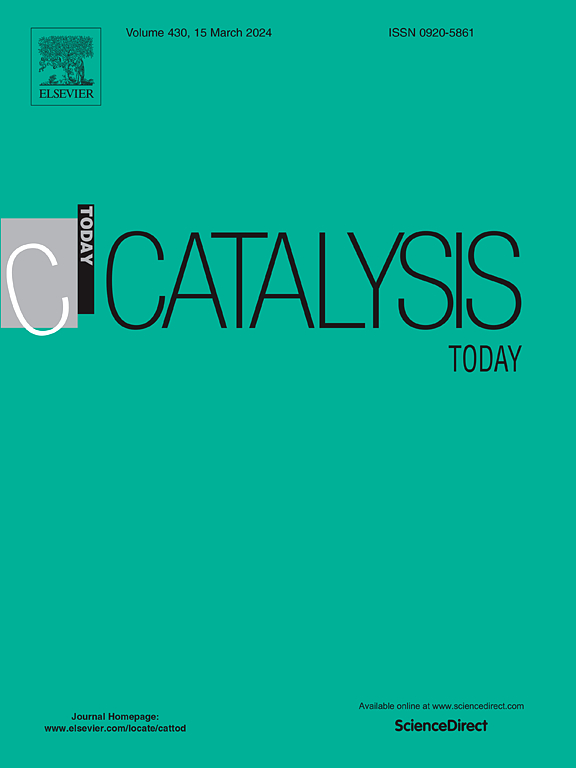Design of 3D printed Mg doped Ni-Co-containing biowaste-derived porous silica as highly-effective catalysts for CO2 methanation
IF 5.2
2区 化学
Q1 CHEMISTRY, APPLIED
引用次数: 0
Abstract
Mesoporous silica (MS) derived from rice husk was doped with Mg and additionally modified with Ni and/or Co by incipient wetness impregnation method. 3D printing technology was applied before or after the modification with metal precursors for better performance of the obtained catalysts in a larger scale CO2 hydrogenation. The initial silica and the modified materials were characterized by X-ray powder diffraction (XRD), transmission electron microscopy (TEM), N2 physisorption, temperature-programmed reduction (TPR-TGA), and X-ray photoelectron spectroscopy (XPS). The formation of a rock salt (Ni,Mg,Co)O phase and a highly dispersed spinel (Ni,Mg,Co)₃O₄ phase was registered. It was found that optimal Mg doping significantly influences the dispersion of the formed metal oxide species. The peculiarities of the applied mesoporous silica could influence metal dispersion as well. The obtained catalysts are active in CO2 hydrogenation to methane. The optimal Ni-Co ratio and the moderate-strength basic sites promote high CO2 conversion and CH₄ selectivity. Among them, powder 5Mg5Ni5Co/MS material was selected for 3D printing based on its high activity and the optimal content of nickel from an economical point of view. The stabilization of Ni dispersion in the 3D-printed samples is beneficial for long-term catalytic performance. The advantage of the 3D printed catalysts was demonstrated showing their higher activity in CO2 hydrogenation than that of their powder analog, keeping high CO2 conversion of around 3.8 mol CO2 g cat −1 h−1 in 6 hours reaction time. The favorable catalytic properties of the 3D printed catalysts, their stability and reusability indicate their potential for commercialization.
3D打印含Mg掺杂ni -co的生物废物衍生多孔二氧化硅作为二氧化碳甲烷化的高效催化剂的设计
采用初湿浸渍法对稻壳中介孔二氧化硅(MS)进行了Mg掺杂和Ni或Co修饰。为了在更大规模的CO2加氢中获得更好的性能,在金属前驱体改性前后应用3D打印技术。采用x射线粉末衍射(XRD)、透射电子显微镜(TEM)、N2物理吸附、程序升温还原(TPR-TGA)和x射线光电子能谱(XPS)对初始二氧化硅和改性材料进行了表征。记录了岩盐(Ni,Mg,Co)O相和高度分散的尖晶石(Ni,Mg,Co)₃O₄相的形成。结果表明,最佳的Mg掺杂对形成的金属氧化物的分散性有显著影响。介孔二氧化硅的特性也会影响金属的分散。所制得的催化剂在CO2加氢制甲烷中具有活性。最佳的Ni-Co比和中等强度的碱基位点促进了高的CO2转化率和CH₄选择性。其中,基于5Mg5Ni5Co/MS粉末材料的高活性和从经济角度考虑的最佳镍含量,选择了5Mg5Ni5Co/MS粉末材料进行3D打印。3d打印样品中镍分散体的稳定有利于长期的催化性能。3D打印催化剂的优势在于其具有比粉末催化剂更高的CO2加氢活性,在6 小时的反应时间内保持了3.8 mol CO2 g cat−1 h−1左右的高CO2转化率。3D打印催化剂的良好催化性能、稳定性和可重复使用性表明其具有商业化潜力。
本文章由计算机程序翻译,如有差异,请以英文原文为准。
求助全文
约1分钟内获得全文
求助全文
来源期刊

Catalysis Today
化学-工程:化工
CiteScore
11.50
自引率
3.80%
发文量
573
审稿时长
2.9 months
期刊介绍:
Catalysis Today focuses on the rapid publication of original invited papers devoted to currently important topics in catalysis and related subjects. The journal only publishes special issues (Proposing a Catalysis Today Special Issue), each of which is supervised by Guest Editors who recruit individual papers and oversee the peer review process. Catalysis Today offers researchers in the field of catalysis in-depth overviews of topical issues.
Both fundamental and applied aspects of catalysis are covered. Subjects such as catalysis of immobilized organometallic and biocatalytic systems are welcome. Subjects related to catalysis such as experimental techniques, adsorption, process technology, synthesis, in situ characterization, computational, theoretical modeling, imaging and others are included if there is a clear relationship to catalysis.
 求助内容:
求助内容: 应助结果提醒方式:
应助结果提醒方式:


